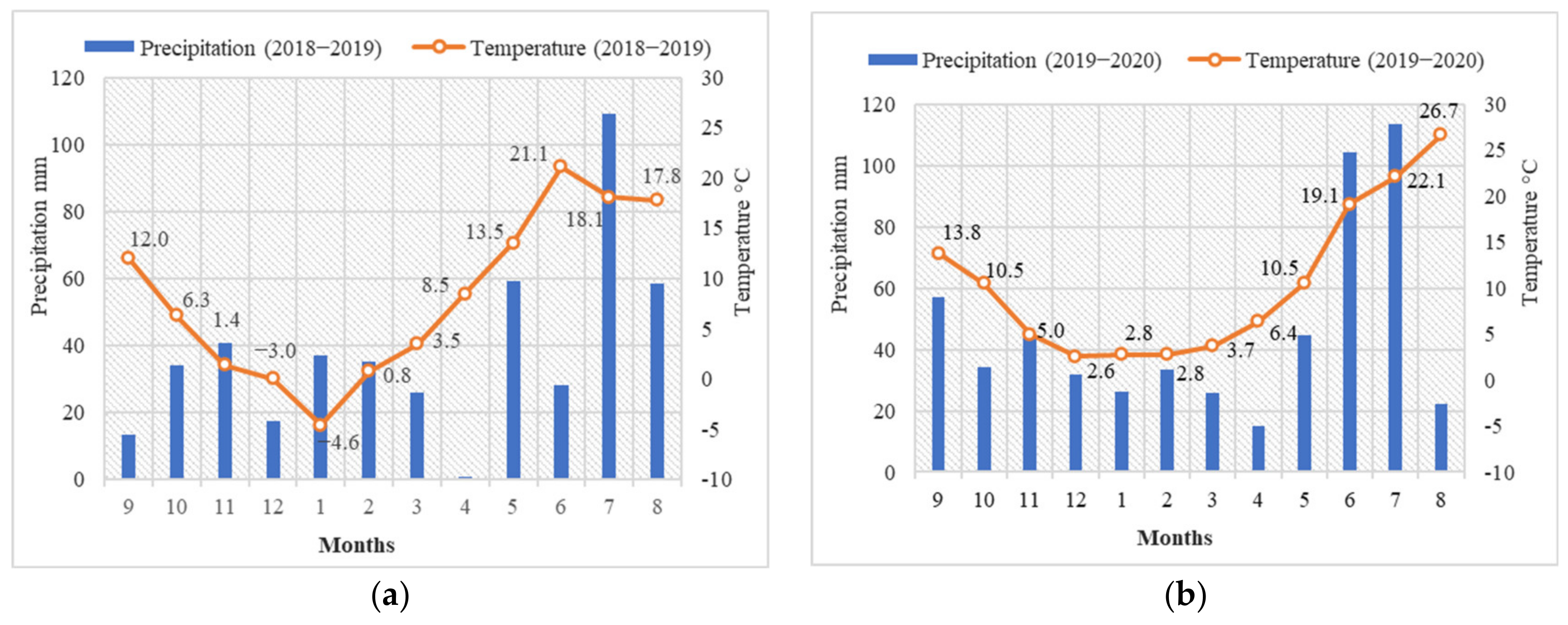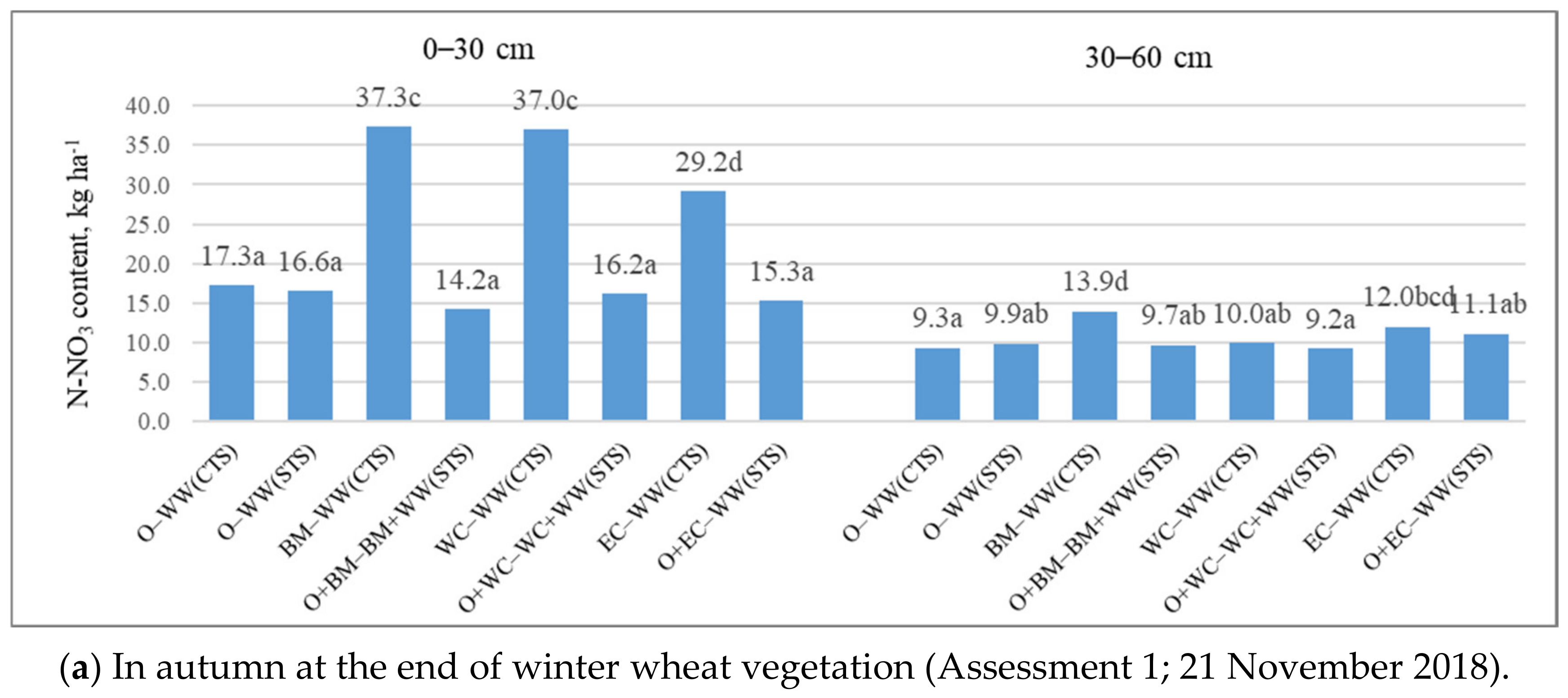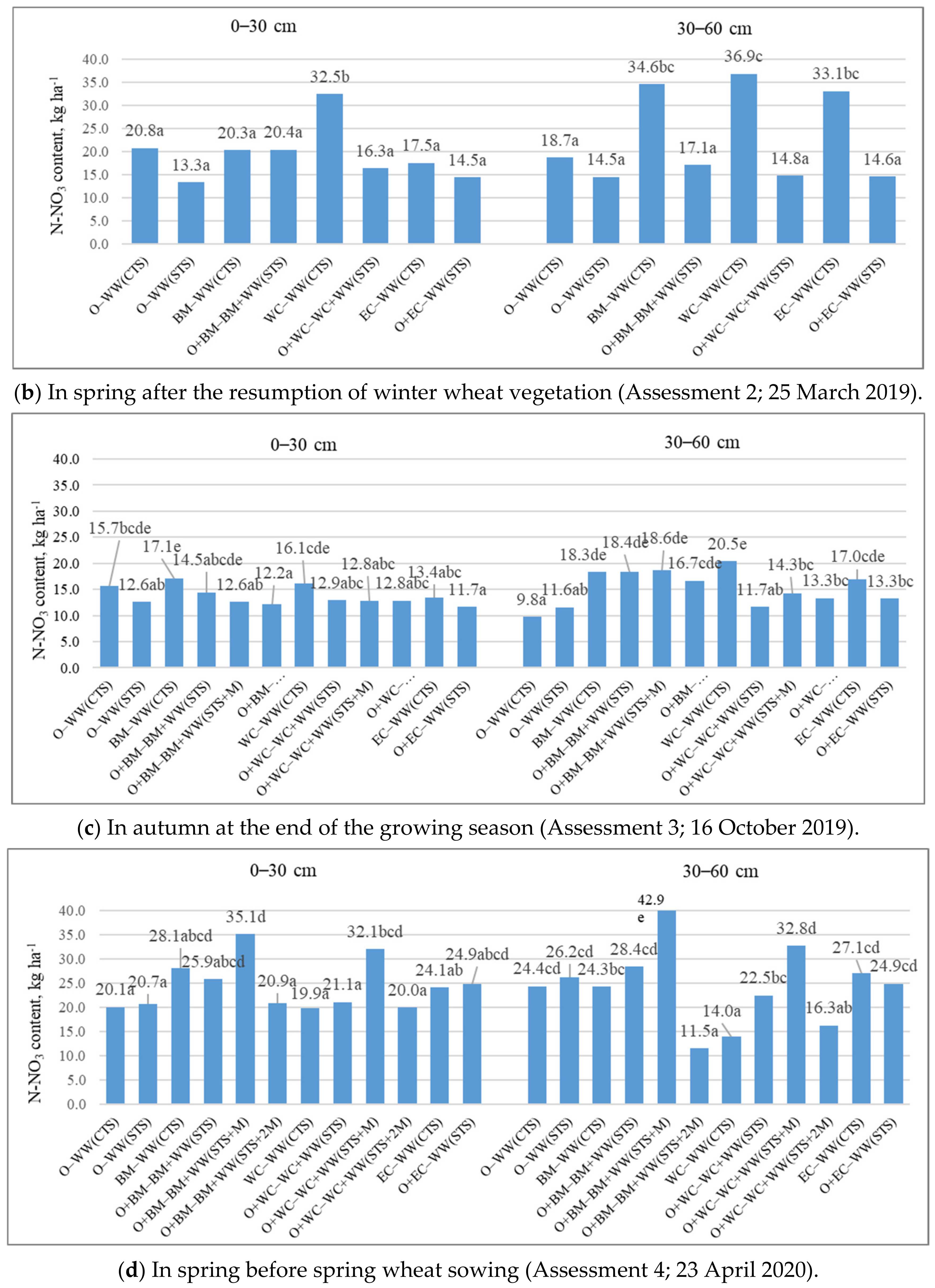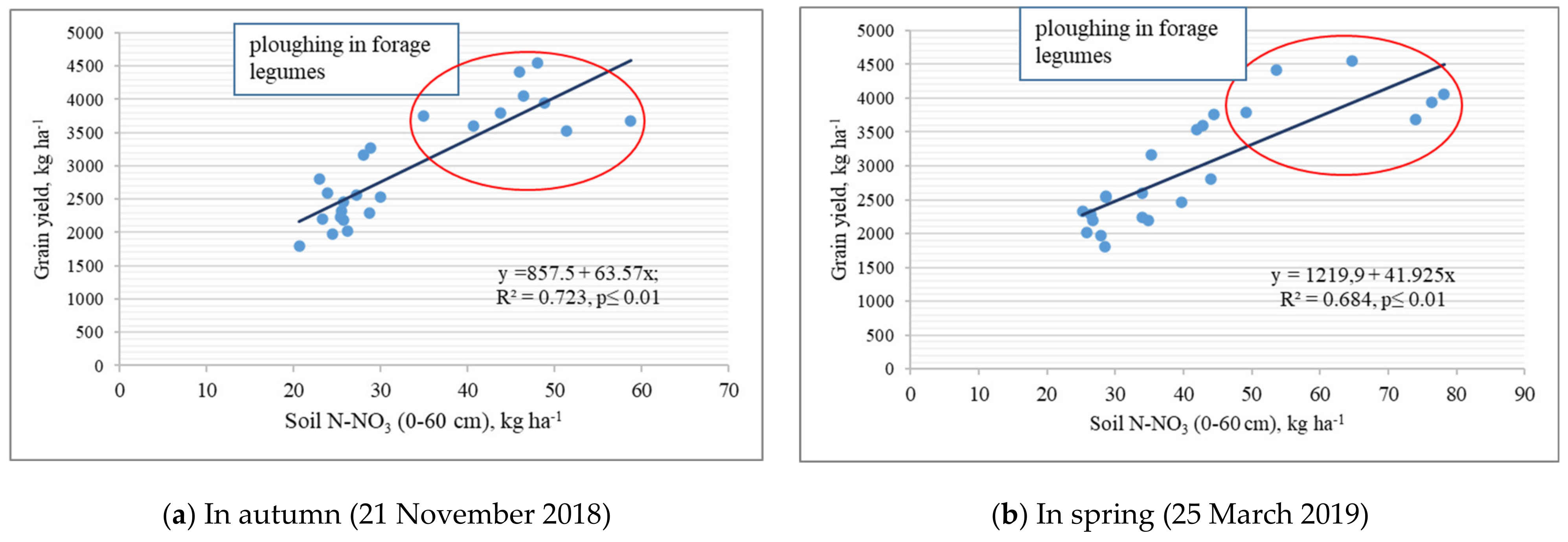Soil Nitrate Nitrogen Content and Grain Yields of Organically Grown Cereals as Affected by a Strip Tillage and Forage Legume Intercropping
Abstract
:1. Introduction
2. Materials and Methods
2.1. Experimental Site, Soil, and Design
2.2. Experimental Setup
2.3. Weather Conditions
2.4. Plant and Soil Analyses
2.5. Statistical Analysis
3. Results
3.1. Soil Nitrate Nitrogen Content
3.2. Cereal Productivity
4. Discussion
4.1. Nitrogen Supply for Winter Wheat
4.2. Variation in Winter Wheat Yield
5. Conclusions
Author Contributions
Funding
Institutional Review Board Statement
Informed Consent Statement
Data Availability Statement
Acknowledgments
Conflicts of Interest
References
- Gaudin, A.C.M.; Westra, S.; Loucks, C.E.S.; Janovicek, K.; Martin, R.C.; Deen, W. Improving Resilience of Northern Field Crop Systems Using Inter-Seeded Red Clover: A Review. Agronomy 2013, 3, 148–180. [Google Scholar] [CrossRef] [Green Version]
- Rani, K.; Sharma, P.; Kumar, S.; Wati, L.; Kumar, R.; Gurjar, D.S.; Kumar, D. Legumes for Sustainable Soil and Crop Management. In Sustainable Management of Soil and Environment; Springer: Singapore, 2019; pp. 193–215. [Google Scholar]
- McKenna, P.; Cannon, N.; Conway, J.; Dooley, J.; Davies, W.P. Red clover (Trifolium pratense) in conservation agriculture: A compelling case for increased adoption. Int. J. Agric. Sustain. 2018, 16, 342–366. [Google Scholar] [CrossRef]
- Malezieux, E.; Crozat, Y.; Dupraz, C.; Laurans, M.; Makowski, D.; Lafontaine, H.O.; Rapidel, B.; De Tourdonnet, S.; Valantin-Morison, M. Mixing plant species in cropping systems: Concepts, tools and models. A review. Agron. Sustain. Dev. 2009, 29, 43–62. [Google Scholar] [CrossRef] [Green Version]
- Blesh, J. Feedbacks between nitrogen fixation and soil organic matter increase ecosystem functions in diversified agroecosystems. Ecol. Appl. 2019, 29, e01986. [Google Scholar] [CrossRef] [PubMed]
- Franco, J.G.; King, S.R.; Masabni, J.G.; Volder, A. Plant functional diversity improves short-term yields in a low-input intercropping system. Agric. Ecosyst. Environ. 2015, 203, 1–10. [Google Scholar] [CrossRef]
- Gecaitė, V.; Arlauskienė, A.; Cesevičienė, J. Competition effects and productivity in oat–forage legume relay inter-cropping systems under organic farming conditions. Agriculture 2021, 11, 99. [Google Scholar] [CrossRef]
- Casagrande, M.; Peigné, J.; Payet, V.; Mäder, P.; Sans, F.X.; Blanco-Moreno, J.M.; Antichi, D.; Bàrberi, P.; Beeckman, A.; Bigongiali, F.; et al. Organic farmers’ motivations and challenges for adopting conservation agriculture in Europe. Org. Agric. 2015, 6, 281–295. [Google Scholar] [CrossRef]
- Arlauskiene, A.; Jablonskyte-Rasce, D.; Slepetiene, A. Effect of legume and legume-festulolium mixture and their mulches on cereal yield and soil quality in organic farming. Arch. Agron. Soil Sci. 2020, 66, 1058–1073. [Google Scholar] [CrossRef]
- Hansen, E.; Eriksen, J. Nitrate leaching in maize after cultivation of differently managed grass-clover leys on coarse sand in Denmark. Agric. Ecosyst. Environ. 2016, 216, 309–313. [Google Scholar] [CrossRef]
- De Notaris, C.; Rasmussen, J.; Sørensen, P.; Olesen, J.E. Nitrogen leaching: A crop rotation perspective on the effect of N surplus, field management and use of catch crops. Agric. Ecosyst. Environ. 2018, 255, 1–11. [Google Scholar] [CrossRef]
- Thomsen, I.K.; Crop, N. Utilization and leaching losses as affected by time and method of application of farmyard manure. Eur. J. Agron. 2005, 22, 1–9. [Google Scholar] [CrossRef]
- Lal, R.; Reicosky, D.C.; Hanson, J.D. Evolution of the plow over 10,000 years and therationale for no-till farming. Soil Tillage Res. 2007, 93, 1–12. [Google Scholar] [CrossRef]
- Askegaard, M.; Olesen, J.E.; Rasmussen, I.; Kristensen, K. Nitrate leaching from organic arable crop rotations is mostly determined by autumn field management. Agric. Ecosyst. Environ. 2011, 142, 149–160. [Google Scholar] [CrossRef]
- Skaalsveen, K.; Ingram, J.; Clarke, L.E. The effect of no-till farming on the soil functions of water purification and re-tention in north-western Europe: A literature review. Soil Tillage Res. 2019, 189, 98–109. [Google Scholar] [CrossRef]
- Blanco-Canqui, H.; Ruis, S.J. No-tillage and soil physical environment. Geoderma 2018, 326, 164–200. [Google Scholar] [CrossRef]
- Büchia, L.; Wendlinga, M.; Amosséa, C.; Necpalovac, M.; Charles, R. Importance of cover crops in alleviating negative effects of reduced soil tillage and promoting soil fertility in a winter wheat cropping system. Agric. Ecosyst. Environ. 2018, 256, 92–104. [Google Scholar] [CrossRef]
- Novara, A.; Gristina, L.; Saladino, S.; Santoro, A.; Cerdà, A. Soil erosion assessment on tillage and alternative soil managements in a Sicilian vineyard. Soil Tillage Res. 2011, 117, 140–147. [Google Scholar] [CrossRef] [Green Version]
- Pittelkow, C.; Linquist, B.A.; Lundy, M.E.; Liang, X.; van Groenigen, K.J.; Lee, J.; van Gestel, N.; Six, J.; Venterea, R.T.; van Kessel, C. When does no-till yield more? A global meta-analysis. Field Crop. Res. 2015, 183, 156–168. [Google Scholar] [CrossRef] [Green Version]
- Weyers, S.L.; Archer, D.W.; Forcella, F.; Gesch, R.; Johnson, J.M. Strip-tillage reduces productivity in organically managed grain and forage cropping systems in the Upper Midwest, USA. Renew. Agric. Food Syst. 2018, 33, 309–321. [Google Scholar] [CrossRef]
- Cooper, J.; Baranski, M.; Stewart, G.; Nobel-de Lange, M.; Bàrberi, B.; Fließbach, A.; Peigné, J.; Berner, A.; Brock, C.; Casagrande, M.; et al. Shallow non-inversion tillage in organic farming maintains crop yields and increases soil C stocks: A meta-analysis. Agron. Sustain. Dev. 2016, 36, 1–22. [Google Scholar] [CrossRef]
- Grosse, M.; Haase, T.; Heß, J. Tillage System Comparison in Organic Farming: Effects on N Mineralization, Soil Microbial Biomass, and Yield. Org. Farming 2019, 5, 23–36. [Google Scholar] [CrossRef] [Green Version]
- VandenBygaart, A. The myth that no-till can mitigate global climate change. Agric. Ecosyst. Environ. 2016, 216, 98–99. [Google Scholar] [CrossRef]
- Peigné, J.; Ball, B.C.; Roger-Estrade, J.; David, C. Is conservation tillage suitable for organic farming? A Review. Soil Use Manag. 2007, 23, 129–144. [Google Scholar] [CrossRef]
- Anderson, R.L. Integrating a complex rotation with no-till improves weed management in organic farming. A review. Agron. Sustain. Dev. 2015, 35, 967–974. [Google Scholar] [CrossRef] [Green Version]
- Ginakes, P.; Grossman, J.; Baker, J.; Sooksa-Nguan, T. Tillage intensity influences nitrogen cycling in organic kura clover living mulch. Nutr. Cycl. Agroecosyst. 2020, 116, 71–82. [Google Scholar] [CrossRef]
- Mäder, P.; Berner, A. Development of reduced tillage systems in organic farming in Europe. Renew. Agric. Food Syst. 2011, 27, 7–11. [Google Scholar] [CrossRef] [Green Version]
- Nunes, M.R.; van Es, H.M.; Schindelbeck, R.; Ristow, A.J.; Ryan, M. No-till and cropping system diversification improve soil health and crop yield. Geoderma 2018, 328, 30–43. [Google Scholar] [CrossRef]
- Peigné, J.; Casagrande, M.; Payet, V.; David, C.; Sans, F.X.; Blanco-Moreno, J.M.; Cooper, J.; Gascoyne, K.; Antichi, D.; Bàrberi, P.; et al. How organic farmers practice conservation agriculture in Europe. Renew. Agric. Food Syst. 2015, 31, 72–85. [Google Scholar] [CrossRef] [Green Version]
- Ranaivoson, L.; Naudin, K.; Ripoche, A.; Affholder, F.; Rabeharisoa, R.L.; Corbeels, M. Agro-ecological functions of crop residues under conservation agriculture. A review. Agron. Sustain. Dev. 2017, 37, 26. [Google Scholar] [CrossRef] [Green Version]
- Pöhlitz, J.; Rücknagel, J.; Koblenz, B.; Schlüter, S.; Vogel, H.-J.; Christen, O. Computed tomography and soil physical measurements of compaction behaviour under strip tillage, mulch tillage and no tillage. Soil Tillage Res. 2018, 175, 205–216. [Google Scholar] [CrossRef]
- Lal, R. No-till farming: Soil and water conservation and management in the humid and subhumid tropics. IITA Monogr. 1983, 2, 64. [Google Scholar]
- Hartwig, N.L.; Ammon, H.U. Cover crops and living mulches. Weed Sci. 2002, 50, 688–699. [Google Scholar] [CrossRef]
- Sarunaite, L.; Kadziuliene, Z.; Deveikyte, I.; Kadziulis, L. Effect of legume biological nitrogen on cereals grain yield and soil nitrogen budget in double-cropping system. J. Food Agric. Environ. 2013, 11, 528–533. [Google Scholar]
- Radicetti, E.; Baresel, J.; El-Haddoury, E.; Finckh, M.; Mancinelli, R.; Schmidt, J.; Alami, I.T.; Udupa, S.; Van Der Heijden, M.; Wittwer, R.; et al. Wheat performance with subclover living mulch in different agro-environmental conditions depends on crop management. Eur. J. Agron. 2018, 94, 36–45. [Google Scholar] [CrossRef]
- WRB. World Reference Base for Soil Resources; World Soil Resources Reports; FAO: Rome, Italy, 2014; p. 189. [Google Scholar]
- Jonathan, R.; Alexander, J.R.; Venterea, R.T.; Baker, J.M.; Coulter, J.A. Kura clover living mulch: Spring management effects on nitrogen. Agronomy 2019, 9, 69. [Google Scholar]
- Watros, A.; Lipińska, H.; Lipiński, W.; Tkaczyk, P.; Krzyszczak, J.; Baranowski, P. Mineral nitrogen content in hydro-graphic areas of Poland depending on land use. Int. Agrophys. 2019, 33, 481–491. [Google Scholar] [CrossRef]
- Walmsley, D.C.; Siemens, J.; Kindler, R.; Kaiser, K.; Saunders, M.; Fichtner, A.; Kaupenjohann, M.; Osborne, B.A. Reduced nitrate leaching from an Irish cropland soil under non-inversion tillage with cover cropping greatly outweighs increased dissolved organic nitrogen leaching. Agric. Ecosyst. Environ. 2018, 265, 340–349. [Google Scholar] [CrossRef]
- Francaviglia, R.; Álvaro-Fuentes, J.; Di Bene, C.; Gai, L.; Regina, K.; Turtola, E. Diversified Arable Cropping Systems and Management Schemes in Selected European Regions Have Positive Effects on Soil Organic Carbon Content. Agriculture 2019, 9, 261. [Google Scholar] [CrossRef] [Green Version]
- He, J.; Shi, Y.; Zhao, J.; Yu, Z. Strip rotary tillage with a two-year subsoiling interval enhances root growth and yield in wheat. Sci. Rep. 2019, 9, 11678. [Google Scholar] [CrossRef] [Green Version]
- Derpsch, R.; Franzluebbers, A.; Duiker, S.; Reicosky, D.; Koeller, K.; Friedrich, T.; Sturny, W.; Sá, J.; Weiss, K. Why do we need to standardize no-tillage research? Soil Tillage Res. 2014, 137, 16–22. [Google Scholar] [CrossRef]
- Vrignon-Brenas, S.; Celette, F.; Piquet-Pissaloux, A.; Corre-Hellou, G.; David, C. Intercropping strategies of white clover with organic wheat to improve the trade-off between wheat yield, protein content and the provision of ecological services by white clover. Field Crop. Res. 2018, 224, 160–169. [Google Scholar] [CrossRef]
- Valkama, E.; Lemola, R.; Känkänen, H.; Turtola, E. Meta-analysis of the effects of undersown catch crops on nitrogen leaching loss and grain yields in the Nordic countries. Agric. Ecosyst. Environ. 2015, 203, 93–101. [Google Scholar] [CrossRef]
- Louarn, G.; Pereira-Lopès, E.; Fustec, J.; Mary, B.; Voisin, A.-S.; Carvalho, P.C.D.F.; Gastal, F. The amounts and dynamics of nitrogen transfer to grasses differ in alfalfa and white clover-based grass-legume mixtures as a result of rooting strategies and rhizodeposit quality. Plant Soil 2014, 389, 289–305. [Google Scholar] [CrossRef]
- Yang, X.M.; Drury, C.F.; Reynolds, W.D.; Phillips, L.A. Nitrogen release from shoots and roots of crimson clover, hairy vetch, and red clover. Can. J. Soil Sci. 2020, 100, 179–188. [Google Scholar] [CrossRef]
- Thorsted, M.; Olesen, J.E.; Weiner, J. Width of clover strips and wheat rows influence grain yield in winter wheat/white clover intercropping. Field Crop. Res. 2006, 95, 280–290. [Google Scholar] [CrossRef]
- Garcia-Franco, N.; Albaladejo, J.; Almagro, M.; Martínez-Mena, M. Beneficial effects of reduced tillage and green manure on soil aggregation and stabilization of organic carbon in a Mediterranean agroecosystem. Soil Tillage Res. 2015, 153, 66–75. [Google Scholar] [CrossRef]
- Weyers, S.L.; Archer, D.W.; Johnson, J.M.F.; Wilts, A.R. Management drives differences in nutrient dynamics in conventional and organic four-year crop rotation systems. Agronomy 2020, 10, 764. [Google Scholar] [CrossRef]
- Wyngaarden, S.L.; Gaudin, A.C.M.; Deen, W.; Martin, R.C. Expanding red clover (Trifolium pratense) usage in the corn–soy–wheat rotation. Sustainability 2015, 7, 15487–15509. [Google Scholar] [CrossRef] [Green Version]
- Six, J.; Elliot, E.T.; Paustian, K. Soil macroaggregate turnover and microaggregate formation: A mechanism for C se-questration under no-tillage agriculture. Soil Biol. Biochem. 2000, 32, 2099–2103. [Google Scholar] [CrossRef]
- Kumar, S.; Kadono, A.; Lal, R.; Dick, W. Long-term no-till impacts on organic carbon and properties of two contrasting soils and corn yields in Ohio. Soil Sci. Soc. Am. J. 2012, 76, 1798–1809. [Google Scholar] [CrossRef] [Green Version]
- Haq, M.I.U.; Maqbool, M.M.; Ali, A.; Farooq, S.; Khan, S.; Saddiq, M.S.; Khan, K.A.; Ali, S.; Khan, M.I.; Hussain, A.; et al. Optimizing planting geometry for barley-Egyptian clover intercropping system in semi-arid sub-tropical climate. PLoS ONE 2020, 15, e0233171. [Google Scholar] [CrossRef]




| Rotation Sequences | Treatments | ||||
|---|---|---|---|---|---|
| 2018 | 2019 | ||||
| Crops | Soil Tillage and WW Sowing | Crops | Mulching of Forage Legumes | Soil Tillage in Autumn | |
| Oat (Control) | Conven- tional tillage: mass of forage legumes and oat straw incorporated into the soil during ploughing at 23–25 cm depth (26 September 2018) and sowing (27 September 2018) | Winter wheat (WW) | Conventional tillage: cereal straw incorporated into the soil during ploughing at 23–25 cm depth (25 October 2019) | O–WW(CTS) | |
| Black medick (BM) | BM–WW(CTS) | ||||
| White clover (WC) | WC–WW(CTS) | ||||
| Egyptian clover (EC) | EC–WW(CTS) | ||||
| Oat | Strip tillage and sowing (26 September 2018) | Conventional tillage: mass of forage legumes and cereal straw incorporated into the soil during ploughing at 23–25 cm depth (25 October 2019 ) | O–WW(STS) | ||
| Oat and undersown black medick (O+BM) | Black medick–winter wheat intercrop (BM+WW) | No | O+BM–BM+WW (STS) | ||
| once (M) (31 May 2019) | O+BM–BM+WW (STS+M) | ||||
| twice (2M) (26 June 2019) | O+BM–BM+WW (STS+2M) | ||||
| Oat and undersown white clover (O+WC) | White clover–winter wheat intercrop (WC+WW) | No | O+WC–WC+WW (STS) | ||
| once (M) (31 May 2019) | O+WC–WC+WW (STS+M) | ||||
| twice (2M) (26 June 2019) | O+WC–WC+WW (STS+2M) | ||||
| Oat and undersown Egyptian clover (O+EC) | Egyptian clover–winter wheat intercrop (EC+WW) | Dead mulch | O+EC–EC+WW (STS) | ||
| 2018 | 2019 | |||
|---|---|---|---|---|
| Crops | Grain Yield of Oat kg ha−1 | Crops, Tillage and Sowing Methods | Grain Yield of Winter Wheat kg ha−1 | Nitrogen Accumulation kg Nha−1 |
| O | 3360 a | WW (CTS) | 2808 d | 57.9 c |
| O | 3360 a | WW (STS) | 2212 abc | 47.1 abc |
| BM | - | WW (CTS) | 3668 e | 84.6 d |
| O+BM | 3372 a | BM+WW (STS) | 2412 bcd | 50.5 abc |
| O+BM | 3372 a | BM+WW (STS+M) | 2449 bcd | 50.2 abc |
| O+BM | 3372 a | BM+WW (STS+2M) | 2340 abc | 46.7 abc |
| WC | - | WW (CTS) | 4138 g | 99.0 f |
| O+WC | 3409 a | WC+WW (STS) | 2151 ab | 44.5 ab |
| O+WC | 3409 a | WC+WW (STS+M) | 1992 a | 41.0 a |
| O+WC | 3409 a | WC+WW (STS+2M) | 2485 bcd | 50.3 abc |
| EC | - | WW (CTS) | 3969 efg | 88.9 def |
| O+EC | 3556 ab | EC+WW (STS) | 2559 cd | 53.9 bc |
Publisher’s Note: MDPI stays neutral with regard to jurisdictional claims in published maps and institutional affiliations. |
© 2021 by the authors. Licensee MDPI, Basel, Switzerland. This article is an open access article distributed under the terms and conditions of the Creative Commons Attribution (CC BY) license (https://creativecommons.org/licenses/by/4.0/).
Share and Cite
Arlauskienė, A.; Gecaitė, V.; Toleikienė, M.; Šarūnaitė, L.; Kadžiulienė, Ž. Soil Nitrate Nitrogen Content and Grain Yields of Organically Grown Cereals as Affected by a Strip Tillage and Forage Legume Intercropping. Plants 2021, 10, 1453. https://doi.org/10.3390/plants10071453
Arlauskienė A, Gecaitė V, Toleikienė M, Šarūnaitė L, Kadžiulienė Ž. Soil Nitrate Nitrogen Content and Grain Yields of Organically Grown Cereals as Affected by a Strip Tillage and Forage Legume Intercropping. Plants. 2021; 10(7):1453. https://doi.org/10.3390/plants10071453
Chicago/Turabian StyleArlauskienė, Aušra, Viktorija Gecaitė, Monika Toleikienė, Lina Šarūnaitė, and Žydrė Kadžiulienė. 2021. "Soil Nitrate Nitrogen Content and Grain Yields of Organically Grown Cereals as Affected by a Strip Tillage and Forage Legume Intercropping" Plants 10, no. 7: 1453. https://doi.org/10.3390/plants10071453
APA StyleArlauskienė, A., Gecaitė, V., Toleikienė, M., Šarūnaitė, L., & Kadžiulienė, Ž. (2021). Soil Nitrate Nitrogen Content and Grain Yields of Organically Grown Cereals as Affected by a Strip Tillage and Forage Legume Intercropping. Plants, 10(7), 1453. https://doi.org/10.3390/plants10071453








